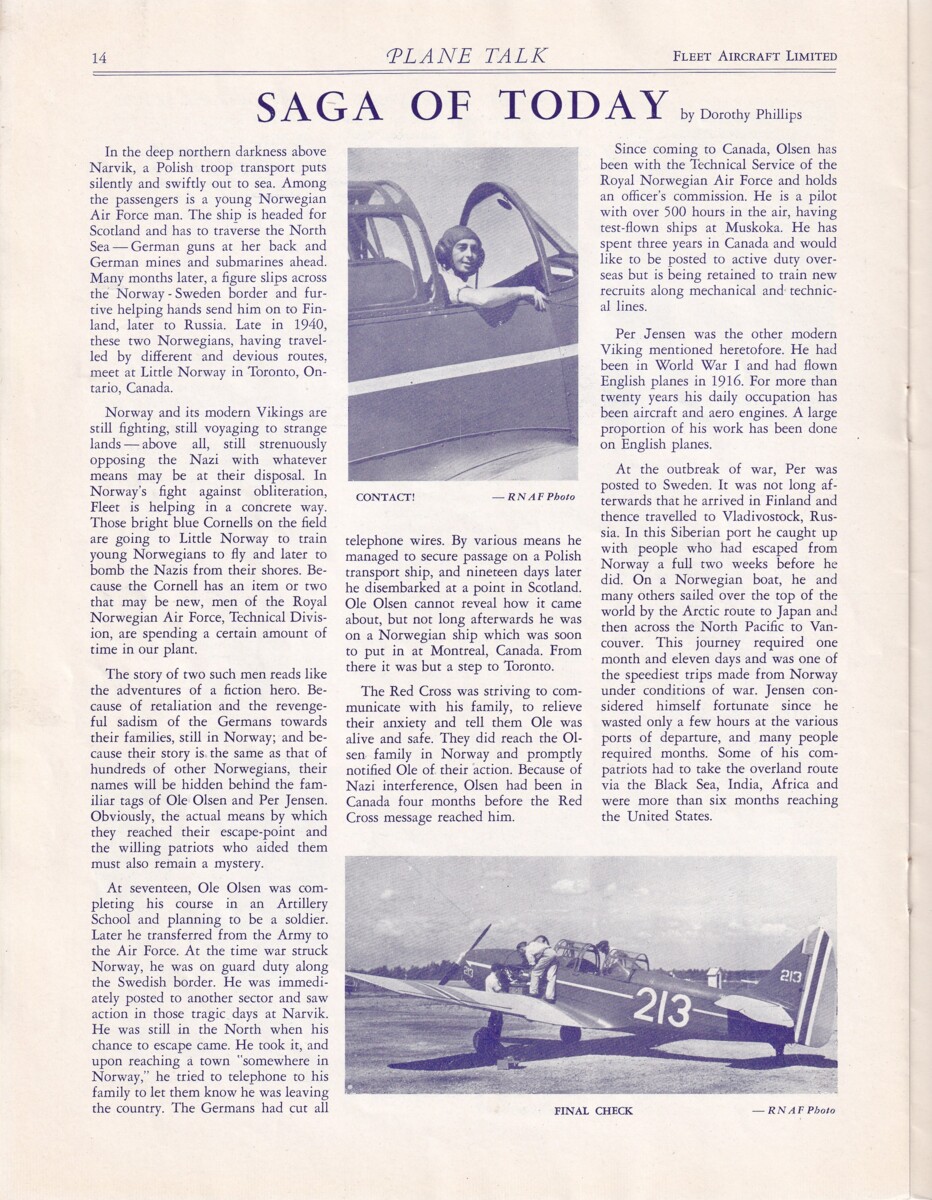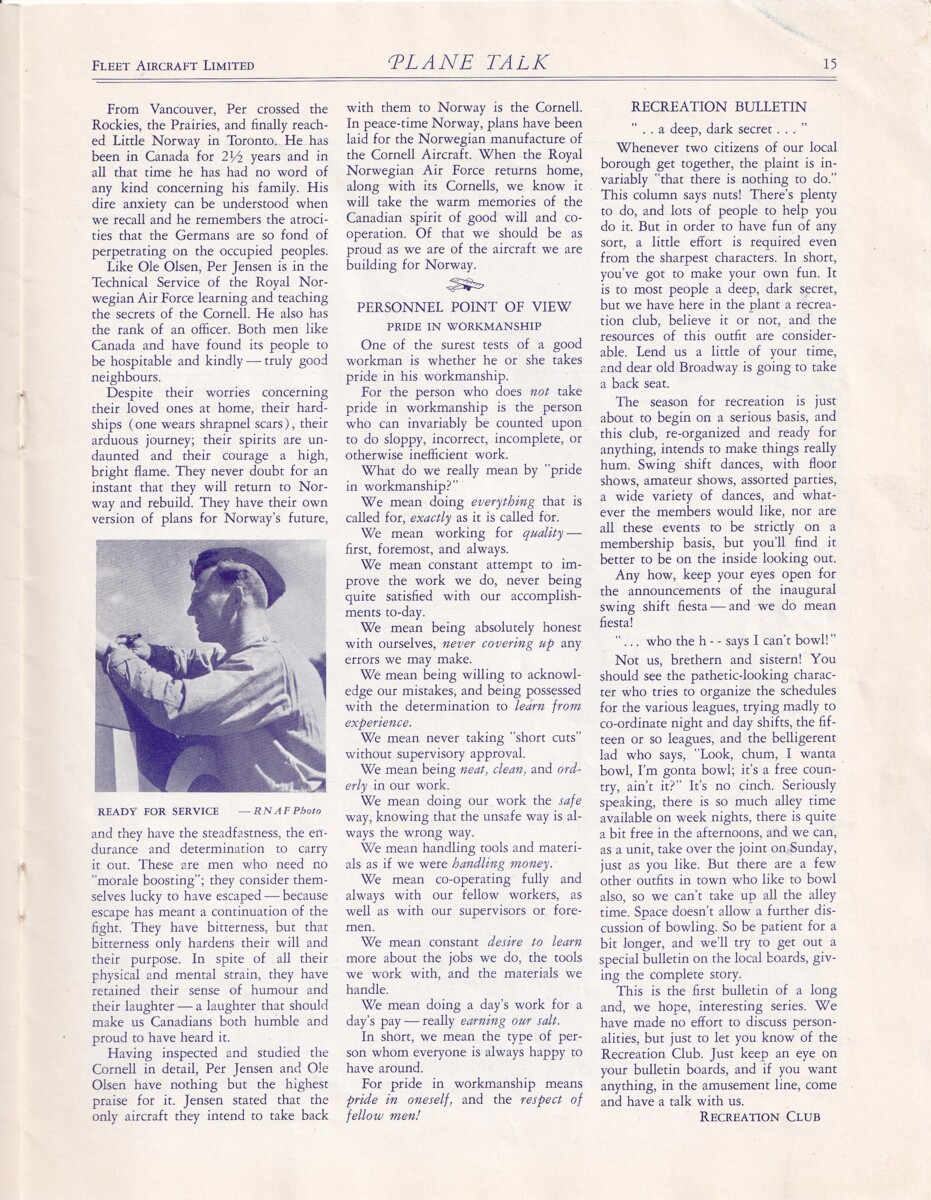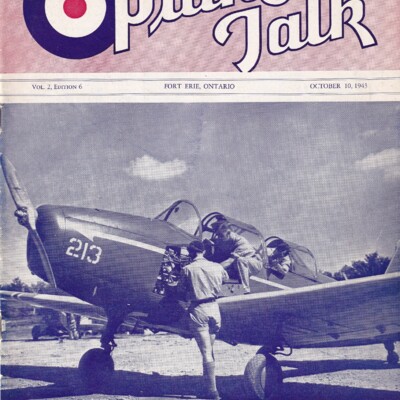Article: Saga of Today (October 1943)
Item
Title
Article: Saga of Today (October 1943)
Description
Pages 14 - 15 from the October 1943 edition of Plane Talk, Vol 2, Edition 6, the periodical magazine for the workers of Fleet Aircraft Limited, Fort Erie, Ontario.
The article describes Fleet Aircraft Limited's production of Cornell aircraft used by the Royal Norwegian Air Force and the stories of two men of the RNAF Technical Division in how they escaped from occupied Norway and made their way to Canada and eventually to Little Norway in Toronto, Ontario.
SAGA OF TODAY
by Dorothy Phillips
14
In the deep northern darkness above Narvik, a Polish troop transport puts silently and swiftly out to sea. Among the passengers is a young Norwegian Air Force man. The ship is headed for Scotland and has to traverse the North Sea - German guns at her back and German mines and submarines ahead. Many months later, a figure slips across the Norway - Sweden border and furtive helping hands send him on to Finland, later to Russia. Late in 1940, these two Norwegians, having travelled by different and devious routes, meet at Little Norway in Toronto, Ontario, Canada.
Norway and its modern Vikings are still fighting, still voyaging to strange lands - above all, still strenuously opposing the Nazi with whatever means may be at their disposal. In Norway’s fight against obliteration, Fleet is helping in a concrete way. Those bright Blue Cornells on the field are going to Little Norway to train young Norwegians to fly and later to bomb the Nazis from their shores. Because the Cornell has an item or two that may be new, men of the Royal Norwegian Air Force, Technical Division, are spending a certain amount of time in our plant.
The story of two such men reads like the adventures of a fiction hero. Because of retaliation and the revengeful sadism of the Germans towards their families, still in Norway; and because their story is the same as that of hundreds of other Norwegians, their names will be hidden behind the familiar tags of Ole Olsen and Per Jensen. Obviously, the actual means by which they reached their escape-point and the willing patriots who aided them must also remain a mystery.
At seventeen, Ole Olsen was completing his course in an Artillery School and Planning to be a soldier. Later he transferred from the Army to the Air Force. At the time war struck Norway, he was on guard duty along the Swedish border. He was immediately posted to another sector and saw action in those tragic days at Narvik. He was still in the North when his chance to escape came. He took it, and upon reaching a town “somewhere in Norway,” he tried to telephone to his family to let them know he was leaving the country. The Germans had cut all telephone wires. By various means he managed to secure passage on a Polish transport ship, and nineteen days later he disembarked at a point in Scotland. Ole Olsen cannot reveal how it came about, but not long afterwards he was on a Norwegian ship which was soon to put in at Montreal, Canada. From there it was but a step to Toronto.
The Red Cross was striving to communicate with his family, to relieve their anxiety and tell them Ole was alive and safe. They did reach the Olsen family in Norway and promptly notified Ole of their action. Because of Nazi interference, Olsen had been in Canada four months before the Red Cross message reached him.
Since coming to Canada, Olsen has been with the Technical Service of the Royal Norwegian Air Force and holds an officer’s commission. He is a pilot with over 500 hours in the air, having test-flown ships at Muskoka. He has spent three years in Canada and would like to be posted to active duty overseas but is being retained to train new recruits along mechanical and technical lines.
Per Jensen was the other modern Viking mentioned heretofore. He had been in World War I and had flown English planes in 1916. For more than twenty years his daily occupation has been aircraft and aero engines. A large proportion of his work has been done on English planes.
At the outbreak of war, Per was posted to Sweden. It was not long afterwards that he arrived in Finland and thence traveled to Vladivostok, Russia. In this Siberian port he caught up with people who had escaped from Norway a full two weeks before he did. On a Norwegian boat, he and many others sailed over the top of the world by the Arctic route to Japan and then across the North Pacific to Vancouver. This journey required one month and eleven days and was one of the speediest trips made from Norway under conditions of war. Jensen considered himself fortunate since he wasted only a few hours at the various ports of departure, and many people required months. Some of his compatriots had to take the overland route via the Black Sea, India, Africa and were more than six months reaching the United States.
15
From Vancouver, Per crossed the Rockies, the Prairies, and finally reached Little Norway in Toronto. He has been in Canada for 2½ years and in all that time he has had no word of any kind concerning his family. His dire anxiety can be understood when we recall and he remembers the atrocities that the Germans are so fond of perpetrating on the occupied peoples.
Like Ole Olsen, Per Jensen is in the Technical Service of the Royal Norwegian Air Force learning and teaching the secrets of the Cornell. He also has the rank of an officer. Both men like Canada and have found its people to be hospitable and kindly - truly good neighbours.
Despite their worries concerning loved ones at home, their hardships (one wears shrapnel scars), their arduous journey; their spirits are undaunted and their courage a high, bright flame. They never doubt for an instant that they will return to Norway and rebuild. They have their own version of plans for Norway’s future, and they have a steadfastness, the endurance and determination to carry it out. These are men who need no “morale boosting”; they consider themselves lucky to have escaped - because escape has meant a continuation of the fight. They have bitterness, but that bitterness only hardens their will and their purpose. In spite of all their physical and mental strain, they have retained their sense of humour and their laughter - a laughter that should make us Canadians both humble and proud to have heard it.
Having inspected and studied the Cornell in detail, Per Jensen and Ole Olsen have nothing but the highest praise for it. Jensen stated that the only aircraft they intended to take back with them to Norway is the Cornell. In peace-time Norway, plans have been laid for the Norwegian manufacture of the Cornell Aircraft. When the Royal Norwegian Air Force returns home, along with its Cornells, we know it will take the warm memories of the Canadian spirit of good will and cooperation. Of that we should be as proud as we are of the aircraft we are building for Norway.
The article describes Fleet Aircraft Limited's production of Cornell aircraft used by the Royal Norwegian Air Force and the stories of two men of the RNAF Technical Division in how they escaped from occupied Norway and made their way to Canada and eventually to Little Norway in Toronto, Ontario.
SAGA OF TODAY
by Dorothy Phillips
14
In the deep northern darkness above Narvik, a Polish troop transport puts silently and swiftly out to sea. Among the passengers is a young Norwegian Air Force man. The ship is headed for Scotland and has to traverse the North Sea - German guns at her back and German mines and submarines ahead. Many months later, a figure slips across the Norway - Sweden border and furtive helping hands send him on to Finland, later to Russia. Late in 1940, these two Norwegians, having travelled by different and devious routes, meet at Little Norway in Toronto, Ontario, Canada.
Norway and its modern Vikings are still fighting, still voyaging to strange lands - above all, still strenuously opposing the Nazi with whatever means may be at their disposal. In Norway’s fight against obliteration, Fleet is helping in a concrete way. Those bright Blue Cornells on the field are going to Little Norway to train young Norwegians to fly and later to bomb the Nazis from their shores. Because the Cornell has an item or two that may be new, men of the Royal Norwegian Air Force, Technical Division, are spending a certain amount of time in our plant.
The story of two such men reads like the adventures of a fiction hero. Because of retaliation and the revengeful sadism of the Germans towards their families, still in Norway; and because their story is the same as that of hundreds of other Norwegians, their names will be hidden behind the familiar tags of Ole Olsen and Per Jensen. Obviously, the actual means by which they reached their escape-point and the willing patriots who aided them must also remain a mystery.
At seventeen, Ole Olsen was completing his course in an Artillery School and Planning to be a soldier. Later he transferred from the Army to the Air Force. At the time war struck Norway, he was on guard duty along the Swedish border. He was immediately posted to another sector and saw action in those tragic days at Narvik. He was still in the North when his chance to escape came. He took it, and upon reaching a town “somewhere in Norway,” he tried to telephone to his family to let them know he was leaving the country. The Germans had cut all telephone wires. By various means he managed to secure passage on a Polish transport ship, and nineteen days later he disembarked at a point in Scotland. Ole Olsen cannot reveal how it came about, but not long afterwards he was on a Norwegian ship which was soon to put in at Montreal, Canada. From there it was but a step to Toronto.
The Red Cross was striving to communicate with his family, to relieve their anxiety and tell them Ole was alive and safe. They did reach the Olsen family in Norway and promptly notified Ole of their action. Because of Nazi interference, Olsen had been in Canada four months before the Red Cross message reached him.
Since coming to Canada, Olsen has been with the Technical Service of the Royal Norwegian Air Force and holds an officer’s commission. He is a pilot with over 500 hours in the air, having test-flown ships at Muskoka. He has spent three years in Canada and would like to be posted to active duty overseas but is being retained to train new recruits along mechanical and technical lines.
Per Jensen was the other modern Viking mentioned heretofore. He had been in World War I and had flown English planes in 1916. For more than twenty years his daily occupation has been aircraft and aero engines. A large proportion of his work has been done on English planes.
At the outbreak of war, Per was posted to Sweden. It was not long afterwards that he arrived in Finland and thence traveled to Vladivostok, Russia. In this Siberian port he caught up with people who had escaped from Norway a full two weeks before he did. On a Norwegian boat, he and many others sailed over the top of the world by the Arctic route to Japan and then across the North Pacific to Vancouver. This journey required one month and eleven days and was one of the speediest trips made from Norway under conditions of war. Jensen considered himself fortunate since he wasted only a few hours at the various ports of departure, and many people required months. Some of his compatriots had to take the overland route via the Black Sea, India, Africa and were more than six months reaching the United States.
15
From Vancouver, Per crossed the Rockies, the Prairies, and finally reached Little Norway in Toronto. He has been in Canada for 2½ years and in all that time he has had no word of any kind concerning his family. His dire anxiety can be understood when we recall and he remembers the atrocities that the Germans are so fond of perpetrating on the occupied peoples.
Like Ole Olsen, Per Jensen is in the Technical Service of the Royal Norwegian Air Force learning and teaching the secrets of the Cornell. He also has the rank of an officer. Both men like Canada and have found its people to be hospitable and kindly - truly good neighbours.
Despite their worries concerning loved ones at home, their hardships (one wears shrapnel scars), their arduous journey; their spirits are undaunted and their courage a high, bright flame. They never doubt for an instant that they will return to Norway and rebuild. They have their own version of plans for Norway’s future, and they have a steadfastness, the endurance and determination to carry it out. These are men who need no “morale boosting”; they consider themselves lucky to have escaped - because escape has meant a continuation of the fight. They have bitterness, but that bitterness only hardens their will and their purpose. In spite of all their physical and mental strain, they have retained their sense of humour and their laughter - a laughter that should make us Canadians both humble and proud to have heard it.
Having inspected and studied the Cornell in detail, Per Jensen and Ole Olsen have nothing but the highest praise for it. Jensen stated that the only aircraft they intended to take back with them to Norway is the Cornell. In peace-time Norway, plans have been laid for the Norwegian manufacture of the Cornell Aircraft. When the Royal Norwegian Air Force returns home, along with its Cornells, we know it will take the warm memories of the Canadian spirit of good will and cooperation. Of that we should be as proud as we are of the aircraft we are building for Norway.
Date
Identifier
013.124.001E
Medium
Provenance
The Review Company, Printers, Fort Erie, Canada



